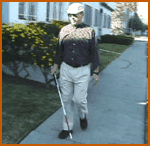|
Michael:
Sometimes
when I've been driving with you, you'll tell me to make a right
turn at the next corner, or to park in the lot just beyond the restaurant.
And you seem to do fine walking around your neighborhood, or even
other neighborhoods, without a cane--negotiating curbs and tricycle-littered
sidewalks pretty well. What sort of visual information are you getting
as you move through the world?
|
|
Joel:
It's like
looking out through a translucent plastic shower curtain that is becoming
very steamed up. Just as, from the shower, you can still see enough
to know that the sink and the toilet, even if blurry and half obscured,
are still there, so I can more or less see my way around. One helpful
thing is that, because my extreme peripheral vision so far remains
fairly clear in all directions, I can at least catch a glimpse of
what I don't look at directly, like those curbs and trikes. When I
start tripping over them, that's when the tip of my white cane will
finally touch down and start scanning the pavement.
|
|
Michael
:
As you walk, is your attention pretty narrowly focused, like
on the one or two feet of sidewalk in front of your shoes?
Or are you "scanning" a lot of the world
around and in front of you?
Joel:
I
walk erect and look straight ahead, scanning from side to
side every few seconds to let the remaining vision in each
eye's far peripheral field catch a glimpse of anything I know
I may be missing in the blotchy view right in front of me.
Out of the corner of my eye, as we say.
|
|

Take
a walk with Joel
|
|
|
|
Michael:
I would
think that, in walking through familiar territory, you would be
working from a mental map drawn up in earlier, more visually lucid,
times--constantly connecting new visual information with what you
remember of past views of the same place. How important is your
memory in getting around?
|
|







